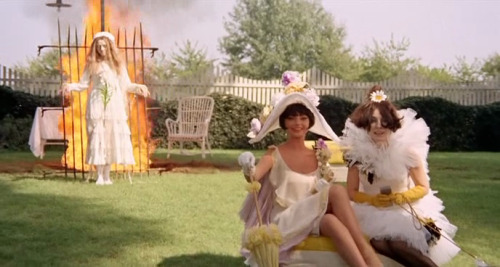YouTube Playlist
1965



Guilietta degla spiriti
In the hands of other directors, a tale of a woman suspecting her husband of adultery and hiring a detective to expose the truth, would be a straightforward piece of filmmaking. But this is Fellini, and as a film that would provide another piece of his transition from his simpler earlier work, the continuation of the themes brought to light in Juliet of the Spirit's immediate predecessor, 8 1/2, take on a new level of surrealism. From the outset, we enter the realm of illusion, with the entire opening sequence shot as a series reflections in mirrors; the images seem real, but we know they are one-dimensional.
Juliet (Giulietta Masina, Fellini's wife in real life), is awaiting her husband's return on their fifteenth anniversary. When he finally arrives, it is clear he has forgotten the occasion, until he reveals the crowd of guests he has brought home with him for a celebration. Among them is a medium, and the evening evolves into a seance, where the psychic reaches across the barriers of the living word to conjure spirits from the dead. As an eerie presence makes itself known, Juliet begins a transformation, and her connection to the spirit world opens wide.

When she hears her husband (Mario Pisu as Giorgio) uttering another woman's name in his sleep, Juliet begins to suspect he is having an affair. Confused by what is happening to her, she seeks counsel from Bishma, a transgendered eunuch who channels accusatory voices from beyond to speak to her. When she meets Suzy (Sandra Milo), her flamboyant and sexually liberal neighbor—replete with a treetop pleasure dome, and staging bordello orgies in the afternoons with her friends—Juliet's repressed sexuality is awakened, as well as distant memories of her childhood, and the encroaching spirit realm intensifies her daily existence. As she comes to terms with her husband's infidelities, she opens herself more to the otherworldly presence, and begins to console in their company. In a style only Fellini could effectively pull off, the story unfolds in a dreamlike visage, merging the real and unreal into an entangled mélange, exploring the subconscious and the indistinct boundaries of the dream state in waking life.
If the effect is highly ethereal, it does manage to present itself in a less overwhelming fashion than the director's later Satyricon, in which his disjointed use of gaudy spectacle is dark and ominous. Here, the connection to the spirit world is warm and welcoming, as Fellini infuses the film with theatrics, from the use of kugato (puppeteers from Japanese bunraki theatre) to the recurring memories that transfix themselves in the flesh before Juliet's eyes. The film is a metaphor for his real life, as his marriage to Giulietta Masina (star of his The Nights of Cabiria and La Strada) was beginning to dematerialize. The influence of the psychic elements stems from the Fellini's involvement with mediums, included in the cast so they could be close to the couple throughout the production. Masina's performance is brilliant, capturing both the awe of the unknown with the security of knowing she is not alone. The supporting cast is typically eccentric in character, which lends a normalcy to Juliet that otherwise wouldn't exist.

Aside from its thematic departures into the abstract, the visual gallantry of the film explodes with spectral intensity. After creating numerous masterpieces in black & white, Fellini's move to color is bold and striking, and there are few who can achieve the richness of color imbued in Juliet of the Spirits. Relying on the talents of cinematographer Gianni di Venanzo (veteran of Antonioni's Le Amiche and Il Grido, Monticelli's Big Deal on Madonna Street, and Fellini's own 8 1/2) , the chromatic depth achieved is provocative, saturated in reds, greens, yellows and blues, all pungent in their display. Shadow and silhouette are also at play, as figures lurk in darkness, outlined by vibrant shards of light betraying their presence as they emerge from the background. Costuming covers the gamut, invoking a carnivalesque montage of flaunted tones with ostentatious pageantry. The image also relies on a sense of depth, created by layering fore- and background objects, framing through portals or curtains, and relaying perspective with tiers of activity. The narrative, while definitely abstract in content, is actually far more palatable than many of Fellini's other films, which can be confusing, to say the least. Fusing fantasies and dreams, Juliet of the Spirits provides a fascinating bridge between Fellini's previous work and the outrageous style that would garner its own bows to the director.


No comments:
Post a Comment